Closing the Racial Achievement Gap in NYC Schools Integration Is Not Enough
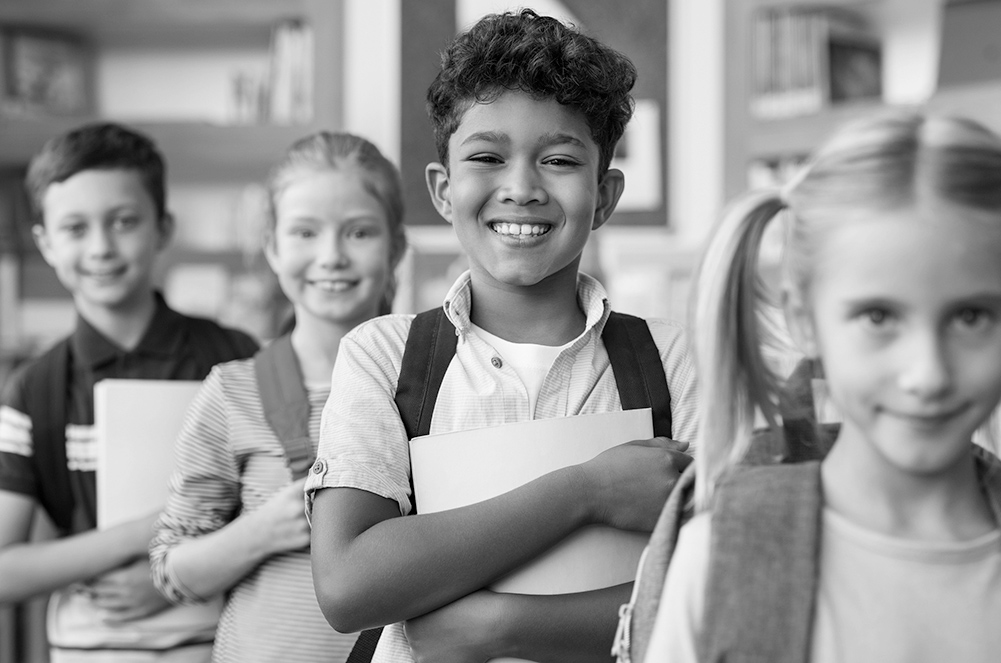
Executive Summary
Mayor Bill de Blasio and Schools Chancellor Richard Carranza want to change the racial makeup of New York City’s schools. Their plan, already under way, is to alter the rules under which many middle schools admit students, as a way of increasing diversity. The goal is to improve the educational opportunities of black and Hispanic students.
The plan has generated opposition, especially among parents of students in selective middle schools. Overlooked in the controversy, however, is demography. The racial and geographic mix of students attending city schools will naturally limit attempts to increase diversity. One key fact: only 16% of the city’s public middle school students are white.
Another key fact: there are many selective middle schools, largely black and Hispanic, whose students attain much higher scores on state exams than the citywide average scores for those groups. These higher-achieving public schools, as well as the city’s high-achieving charter schools, show that academic improvement is possible regardless of a student body’s ethnic mix. Both facts suggest that improving the educational outcomes for black and Hispanic students on a large scale is going to require improving the schools they attend, as well as supporting high-performing charter schools.
School Admissions and Racial Integration: A Long and Winding Road
Admissions policies for public middle schools will seem puzzling for many people. In most U.S. school districts, schools are geographically zoned, meaning that they serve students who live in a particular area. This was also the case in New York City decades ago, but much has changed.
Geographic zoning has been subject to two broad challenges. The first emerged in the decades after the U.S. Supreme Court’s decision in Brown v. Board of Education (1954), which struck down racial segregation of public schools by law. However, the demand for racial integration spread to states and cities where schools simply mirrored the neighborhoods they served, many of which were populated predominantly by families of one racial group or another.
Magnet schools, supported by federal grants, were an effort to break down this isolation. New York City participated in that program, as did many others. Magnet schools, which have specialized curricula (such as the performing arts or STEM), were designed specifically to serve a racially diverse student body. Specialized or enhanced academic programs were designed to alleviate parental concerns that these schools would not compromise the quality of education.
While a number of magnet schools met their goals, the overall program was small. Larger attempts to impose racial integration throughout the New York City system—by redrawing zoning lines or engaging in extensive busing across those lines—met fierce opposition and were largely abandoned by the late 1960s. Changing demographics in the city, meanwhile, resulted in plummeting numbers of white students in the public schools and kept integration off the table for many years.
A second challenge to geographic zoning emerged in the late 1980s. Proponents of greater school choice, myself and the Manhattan Institute included, argued that low student achievement levels in many schools seemed rooted in the very notion of geographic zoning—that schools would essentially be guaranteed students because the system did not allow families to shop around for better schools without changing their residence (or, in a great city tradition, by lying about where they lived). The school choice movement led to the introduction of public charter schools in the city and state. More than 113,000 students were enrolled in New York City charter schools in the 2017–18 school year.[1] These schools offer parents a choice of where their children will be educated. By law, they may not screen students for admission. If a charter receives more applications than it has space for, a lottery determines who is admitted.
School choice also grew within the rest of the public school system (which will be referred to in this report as Department of Education, or DOE, schools), particularly under Mayor Michael Bloomberg’s administration (2002–13). Teachers, administrators, and community partners (neighborhood associations and various non-profits, including colleges) created hundreds of new, small public high schools and middle schools. Many of these new schools (unlike charters) are allowed to screen applicants for admission.
The de Blasio administration is driven by a concern that the concentration of Asian and white students in DOE schools that screen applicants for admission reduces educational opportunities for black and Hispanic students. Thus the mayor and the schools chancellor have recently approved plans by two of the city’s 32 community school districts—District 3 (Upper West Side and West Harlem) and District 15 (Park Slope, Sunset Park, Red Hook, and environs)—to change the rules for admission to their middle schools. The new rules will take effect for the 2019–20 school year.
Today, these two districts do not limit students to the middle school serving their area of residence. Instead, students can apply to middle schools that rank applicants based on some combination of test scores, class grades, and attendance records, with admission being offered to those with the highest combination of those factors.
Under the new rules for District 3, priority admission for 25% of the seats in 16 middle schools will be given to students from low-income families who are low-achieving in either their grades or their math and English Language Arts (ELA) state test results—10% to the lowest-scoring students and 15% to those just below the proficiency cutoffs.[2] District 15 has eliminated academic screening for middle school admissions. Instead, students may apply to any of the district’s middle schools. Seats will be assigned by lottery from among those who choose a school, with extra weight given to students who are poor, English language learners, or homeless.[3] The goal is to spread those students evenly across the district’s middle schools. Slightly fewer than half the district’s students are considered low-income, with fewer students counted as English language learners or homeless.[4]
Of course, these two districts’ middle schools are only the beginning. Mayor de Blasio recently announced his intention to come up with “a series of changes around the screened schools to make sure that they continue to be great schools with a more diverse student body and breaking down some of the mistakes previously in the admissions process that I think were inadvertently in many cases exclusionary.”[5] At the same time, both the mayor and the schools chancellor have ruled out the use of mandatory busing of students across school zones to attain greater racial integration.[6]
Racial Achievement Gaps
Driving the city administration’s plans to increase racial diversity is the strong desire to improve the academic achievement of black and Hispanic students—the long-standing measurable differences in educational outcomes across racial groups in New York City that persist despite periods of general improvement in performance of all groups. A 2017 study by the city’s Independent Budget Office (conducted when I was director of education research at IBO) tracked more than 71,000 students as they progressed from grade 3 (in the 2008–09 school year) through grade 8 (in 2013–14). The results were sobering: not only did black and Hispanic children start out behind their Asian and white peers on the annual ELA and math exams, but they lost ground as they moved through the grades.[7] By grade 8, they were further behind than when they started.
This gap is evident in each year’s results of New York State’s annual examination. Asian and white students are almost twice as likely to be deemed proficient in ELA in grades 3–8; the gap is even higher in math.[8] Meanwhile, proponents of greater integration efforts also point to the racial isolation of many schools in the system. Of the city’s 262 middle schools, 192 have one race in the majority: 90 are majority Hispanic, 69 are majority black, 17 are majority Asian, and 16 are majority white. In 74 of these middle schools, one race accounts for at least 75% of the population: 42 Hispanic, 26 black, 4 white, and 2 Asian.[9]
These numbers are striking—but what they imply for achieving more racial diversity is far from self-evident. That is because the racial makeup of New York City schools is complex.
To understand this complexity, it is useful to begin with some aggregate numbers (Figure 1). In the 2017–18 school year, 1,353,265 students attended NYC schools, of which 113,528 attended public charter schools (where admission is by parental choice). These schools are not diverse. In charters, an overwhelming number of the students—103,196—are black and Hispanic. There were 258,421 students who attended private and parochial schools, of which 170,675 are white, 60,912 are black and Hispanic, and 15,870 are Asian.
And 981,316 students attended traditional public (DOE) schools: 627,638 are black and Hispanic, 156,151 are white, and 172,832 are Asian. But half of the 156,151 white students in DOE schools are located in five of the city’s 32 districts, and 80% are located in 12 districts. In 16 of the 32 DOE school districts, 10% or fewer of the students are white. Asians are similarly concentrated: half the 170,081 Asian/Pacific Islander students are in six districts, and 80% are in 11. In 17 of the DOE school districts, fewer than 10% of students are Asian.[10] This geographic distribution, in short, points to an obvious practical limit to achieving greater racial diversity overall in DOE schools.
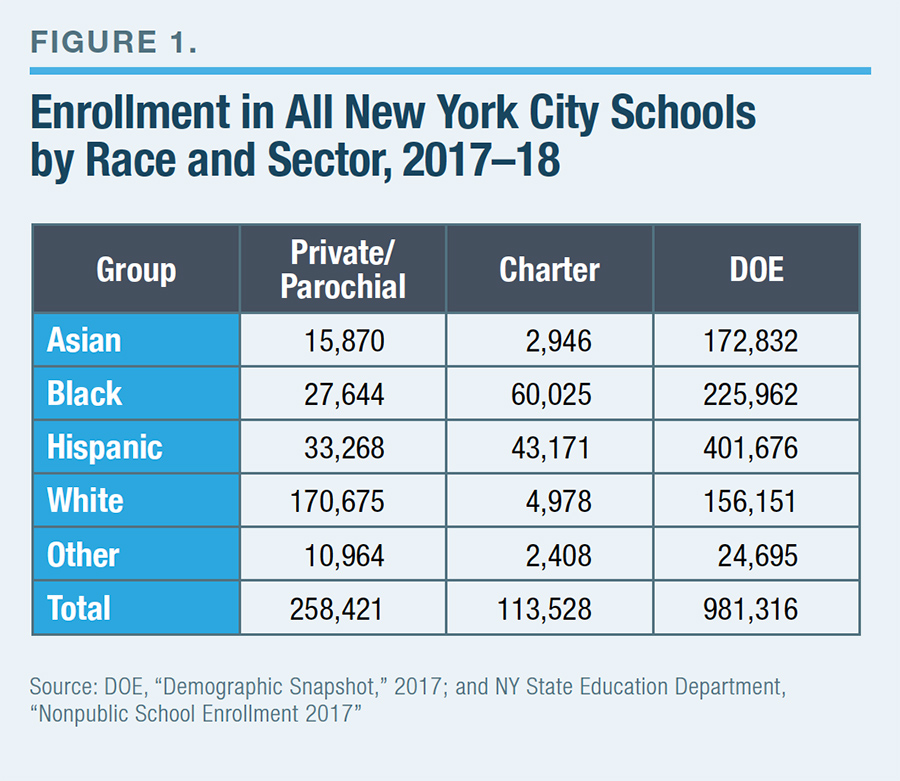
To be sure, the mayor’s plans for racial diversity apply to middle schools, not the overall public school population. Nevertheless, here, too, geography imposes sharp limits. Approximately 24,000 white students are enrolled in DOE middle schools—almost half of whom live on Staten Island or in three community school districts on the Brooklyn side of the Verrazano Bridge.[11]
Moreover, the de Blasio administration’s current diversity plans do not apply to all DOE middle schools. Instead, the focus is on opening spots in middle schools that screen for admission. As Figure 2 shows, 16,999 white students attend middle schools where admission is screened, and 39,946 black and Hispanic students attend middle schools where admission is not screened.[12]
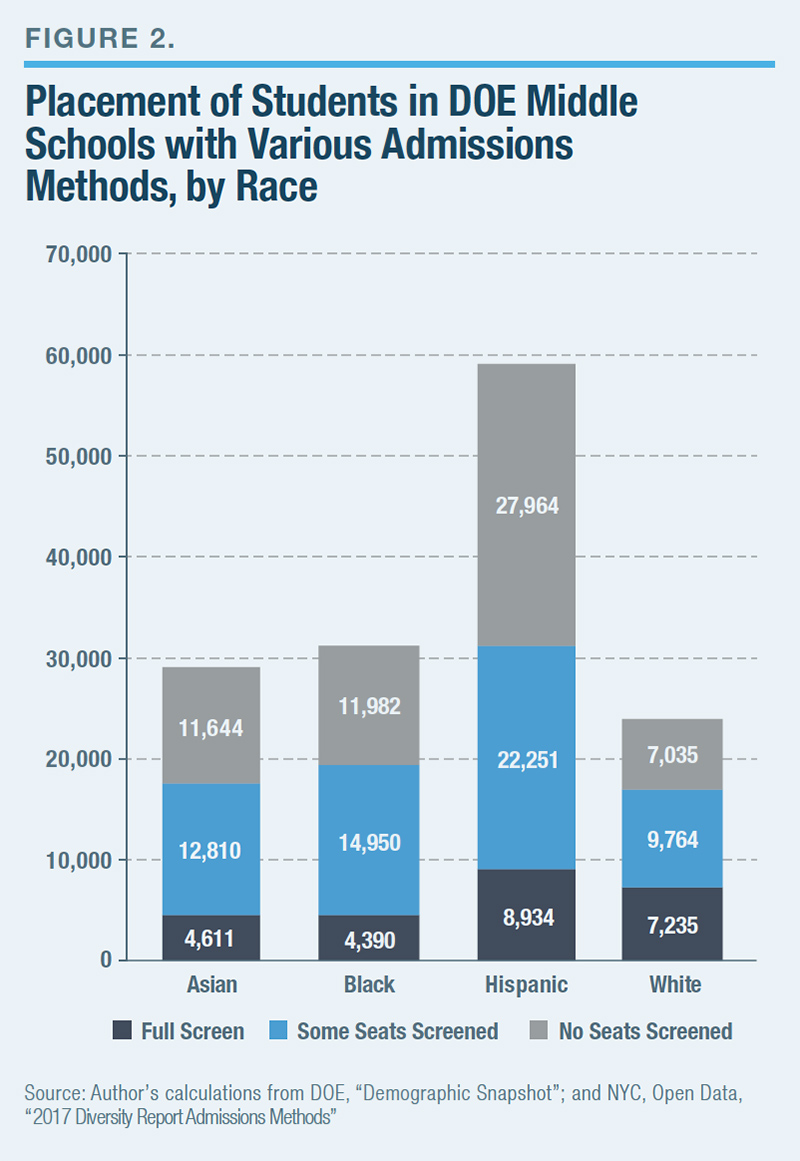
DOE middle schools use a variety of admissions methods, largely determined by the local Community Education Council. Out of 259 middle schools, 108 use no screening method or are geographically zoned; 98 schools use screening for some, but not all, of their seats; 53 schools use screening for all of their seats. Only eight of the 53 schools that are fully screened have white majorities, as are three that are majority Asian. These 11 schools serve fewer than 6,600 Asian and white students.[13] That is not a lot of slots to rearrange in order to attain greater racial integration.
Closing the Racial Achievement Gap: Integration Is Not Enough
There is a clear relationship between the screening methods used by middle schools and the test scores of their students upon admission (Figure 3). Grade 6 is the first year of attendance for students in almost all the middle schools examined in this report. Middle schools that screen all their students have a higher performance profile than schools using no screening or that screen for only some of their seats. This is most clear in the proficiency rates: over half the sixth-graders in fully screened middle schools are deemed proficient in ELA, well above the 33.6% average of all middle schools.
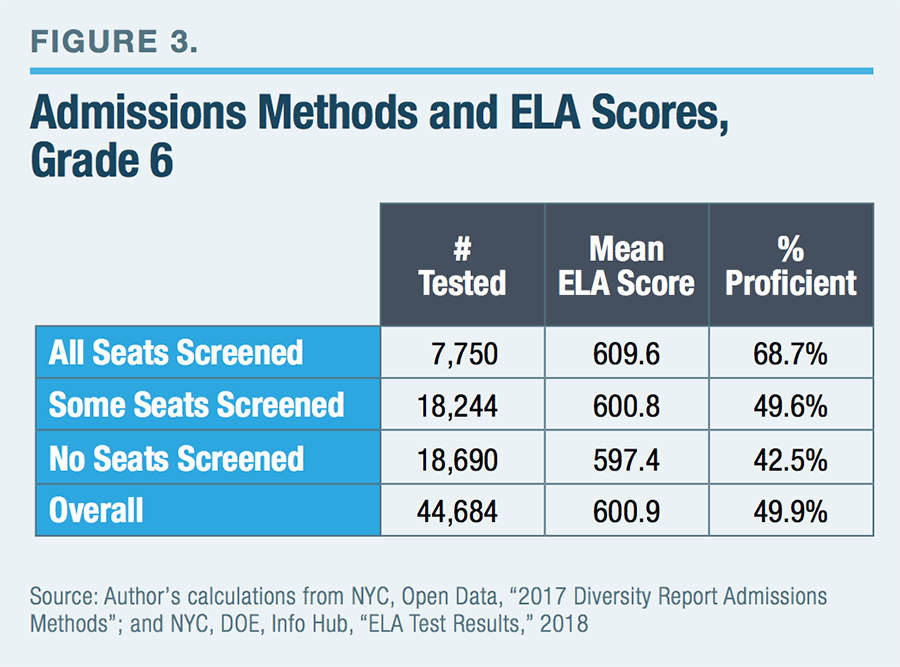
The relationship between test scores and student race is well-known. In the 259 middle schools under study here, Asian and white students are almost twice as likely to score proficient, or above, than are black and Hispanic students (Figure 4). The difference is even greater when looking at the proportion of students who score at the highest level of the exam, level 4. Approximately 50% of white and Asian middle school students in grade 6 score at level 4, compared with roughly 18% for black and Hispanic students. This reality drives much of the racial disparity in admission to the city’s eight specialized high schools—governed largely by scores on the Specialized High School Admissions Test—and the de Blasio administration has also placed admissions to the city’s specialized high schools under scrutiny.[14]

There are areas of hope buried in these gloomy statistics. The first is found in some of DOE’s selective middle schools, majority black and Hispanic, where the test scores of the black and Hispanic students score at proficiency in ELA (Figure 5)—much higher rates than those groups show in the citywide statistics. These schools serve more than 7,700 black and Hispanic students in grades 6–8. Most of them, 21 of 34, are fully screened; seven are unscreened or geographically zoned; and the remaining three screen for some of their seats. Thus, in these schools, the screening mechanism does not seem to disadvantage black and Hispanic students.
One question for DOE leaders to consider is whether these schools might benefit from program upgrades to bring their students to an even higher level of performance. Alternatively, DOE might consider creating more schools like these among the many other middle schools that are majority black and Hispanic.
A second area of hope is in the city’s growing charter school sector. As of 2018, more than 21,000 black or Hispanic students were attending grades 6–8 in 127 charter schools. Those students—none of whom gained admission via test scores—scored higher than their peers in DOE schools, with 51.8% scoring at proficiency in ELA. Results varied across schools, and success was further concentrated in 59 charters, where the proficiency rate for black and Hispanic students was 55% or greater. Overall in these 37 charter schools, 64% of black and Hispanic students scored at proficiency or above in ELA.[15]
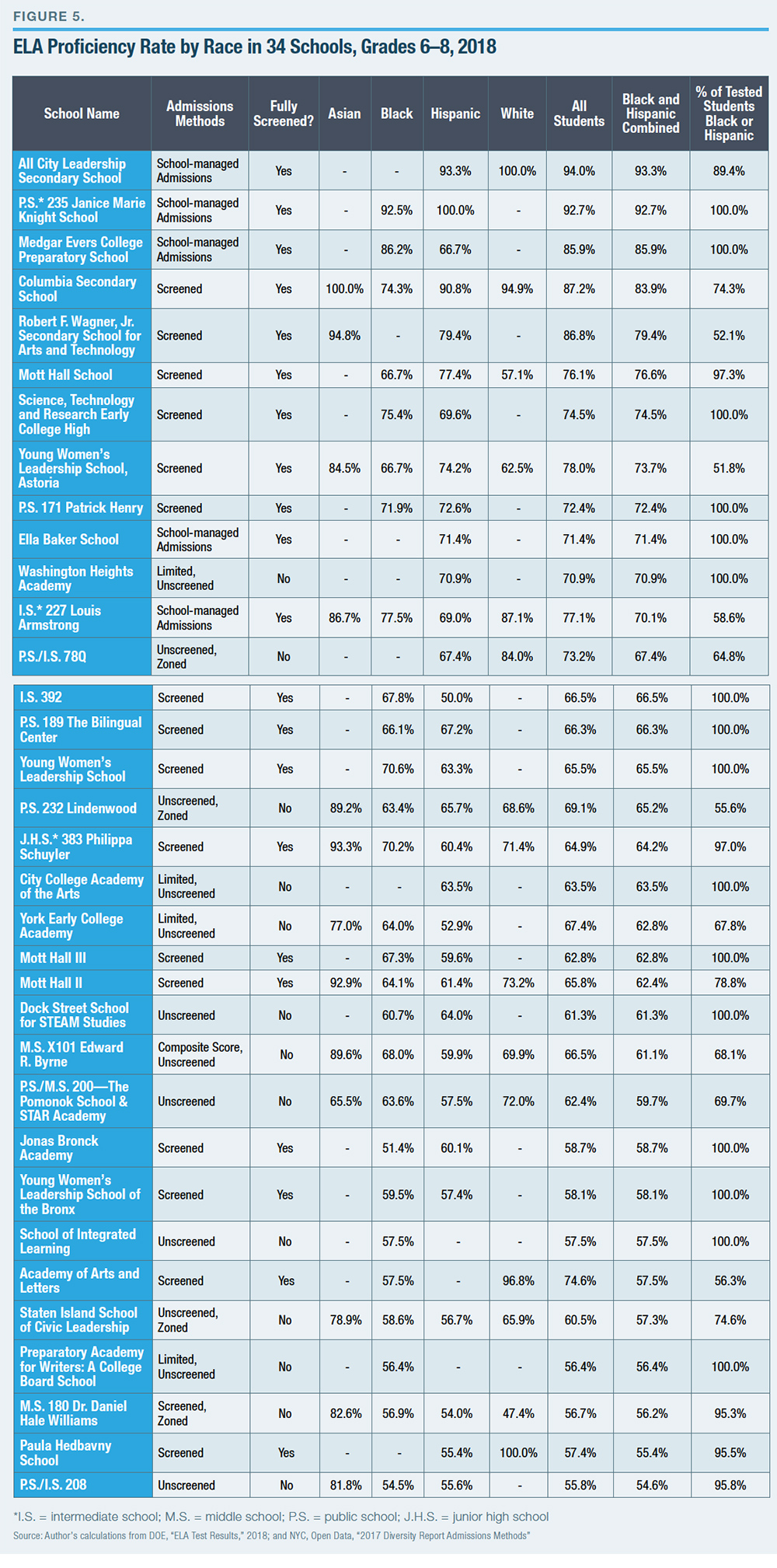
Finally, there is the question of what to do with low-performing DOE schools. Under Mayor Bloomberg, the city engaged in a robust policy of closing low-performing schools while supporting the development of new schools within DOE as well as the charter sector. Mayor de Blasio opposed this approach and has preferred to try to fix low-performing schools through an investment of more than $700 million in his Renewal Schools program. The results have been mixed, at best.
Some of these schools have been closed or merged with other schools. Currently, 28 middle schools are in the program, now named Renewal and Rise Schools; Rise Schools are institutions that the administration has deemed to have improved enough to no longer merit the “renewal” label. Those 28 middle schools enroll 6,500 black and Hispanic students. None of them had more than five students accepted to a selective high school (for student privacy purposes, DOE does not report the exact number when it is 5 or below; for each of these schools, the data indicate “0–5” acceptances).[16]
Conclusion
Given the demographics of the city’s school system, efforts to improve educational opportunities for black and Hispanic students need to move beyond racial integration efforts. The impact of the newly announced changes to the middle schools in Districts 3 and 15 will be seen over time. Yet even if they were to benefit some number of black and Hispanic students at no detriment to Asian or white students, these middle schools contain only a small handful of seats that can be made available to black or Hispanic students.
New York City is still going to be left with a tremendous number of middle schools—selective and nonselective— that are almost exclusively black and Hispanic. These schools need improvement if they are to offer greater educational opportunity to their students.
Endnotes
- See Figure 1, infra.
- New York City, Department of Education (DOE), “Diversity in Admissions.”
- Ibid.
- Author’s calculations from NYC, DOE InfoHub, Information and Data Overview, “Demographic Snapshot.”
- NYC, Office of the Mayor, “Mayor de Blasio Appears Live on the Brian Lehrer Show,” transcript, Sept. 7, 2018.
- Philissa Cramer and Christina Veiga, “Placing Limits on Their Integration Push, Carranza and de Blasio Say Busing Is Off the Table,” Chalkbeat, Sept. 25, 2018.
- “From Grades 3 to 8: Tracing Changes in Achievement Gaps by Race & Gender in New York City Public Schools,” New York City Independent Budget Office, Issue Brief, December 2017.
- DOE, “NYC Results on the New York State 2013–2017 ELA Test (Grades 3–8)”; idem, “NYC Results on the New York State 2013–2017 Math Test (Grades 3–8).”
- Author’s calculations from DOE, “Demographic Snapshot.”
- Author’s calculations from DOE, “Demographic Snapshot.”
- Ibid.
- We refer to 259 middle schools (including intermediate and junior high schools) within DOE, serving almost 150,000 students, almost all of whom are in grades 6, 7, or 8. (Some students in those grades attend different types of schools, including some serving grades K–8 or 6–12; those schools and students are not included in the data in this report.)
- Author’s calculations from DOE, “Demographic Snapshot;” and NYC, Open Data, “2017 Diversity Report Admissions Methods.”
- Elizabeth A. Harris, “De Blasio Proposes Changes to New York’s Elite High Schools,” New York Times, June 2, 2018.
- New York State, Education Department, “2017–18 Assessment Database.”
- Author’s calculations from NYC, Open Data, “2017–2018 SHSAT Admissions Test Offers by Sending School.”
______________________
Ray Domanico is the director of education policy at the Manhattan Institute.
Are you interested in supporting the Manhattan Institute’s public-interest research and journalism? As a 501(c)(3) nonprofit, donations in support of MI and its scholars’ work are fully tax-deductible as provided by law (EIN #13-2912529).